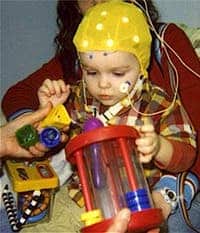Parents with autistic children typically have no way of knowing whether their children’s early, yet mild signs of autism will develop into severe impairments. They’re forced to wait, which is most often one of the worst things to do, especially for a parent. Recently, researchers at University of Washington have reported that a distinct ripple of brain waves measured while toddlers listen to words can reliably predict how they will fare in a range of cognitive areas up to age 6—the longest-term forecast yet achieved. The findings are extremely important not only because they offer a better way of assessing autism and thus effectively applying treatment, but also because they show how early social abilities facilitate the development of language.

Deficits in acquiring language and social skills are telltale signs of autism spectrum disorder (ASD), however neurologically speaking, the brain systems that govern these two types of deficits are taken separately. Patricia Kuhl, a cognitive neuroscientist at the University of Washington, Seattle, and lead author of the new study, believes this isn’t quite so. Instead, the two are intertwined.
Previously, it was shown that when a child up to 20 months old hears word never encountered before, a characteristic uptick in brain waves in the left hemisphere of the brain can be detected through electroencephalography (EEG). Kuhl wanted to see if this is consisting with social ability in children with autism, so she performed tests on two dozen 2-year-olds with ASD.
The children had noninvasive sensors attached to their heads which read brain waves, while their parents were instructed by the researchers to speak words that were familiar to the children like “car,” “book,” or “shoe,” along with ith unfamiliar ones such as “pint,” or “guide.” On average, the children did not show the signature uptick in brain activity in response to unknown words, Kuhl says. When she divided them into two subgroups based on their scores on a standard test of social cognition, however, she saw a striking pattern. Children with the lowest scores on the social cognition tests showed atypical responses to the unknown words—no response at all, for example, or activity in a different part of the brain, while those with the higher scores showed a more typical pattern of brain activation in the left hemisphere.
Interesting enough, the discovery follows in the heels of another recent research that demonstrated for the first time that it is possible to confirm or independently assess clinical diagnoses of autism in children simply by analyzing their brain activity.
What the findings suggest is that these markers could be used as a measure to predict who’s going to do well. The results fit well with other studies of how sociality can influence language skills, says Debbie Mills, a cognitive neuroscientist at Bangor University in the United Kingdom. In people with Williams syndrome, which is characterized by a strong drive for social interaction, she says, one sees an opposite electrical brain response to similar linguistic tests than that seen in people with autism.
Findings appeared in the journal PLOS ONE. [via Science]






